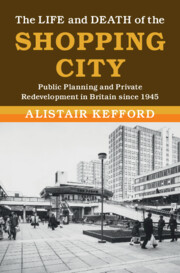 The Life and Death of the Shopping City
The Life and Death of the Shopping City Book contents
- The Life and Death of the Shopping City
- Modern British Histories
- The Life and Death of the Shopping City
- Copyright page
- Dedication
- Contents
- Figures
- Acknowledgements
- Introduction
- 1 Reconstructing Retail in the 1940s
- 2 Cities in the Age of Affluence
- 3 Making the Modern Shopping City
- 4 The Politics of Partnership
- 5 Landscapes of Leisure
- 6 Demand and Discontent in the Shopping City
- 7 Triumph of the Shopping City
- Conclusion
- List of Archives and Abbreviations
- Bibliography
- Index
7 - Triumph of the Shopping City
Published online by Cambridge University Press: 31 March 2022
- The Life and Death of the Shopping City
- Modern British Histories
- The Life and Death of the Shopping City
- Copyright page
- Dedication
- Contents
- Figures
- Acknowledgements
- Introduction
- 1 Reconstructing Retail in the 1940s
- 2 Cities in the Age of Affluence
- 3 Making the Modern Shopping City
- 4 The Politics of Partnership
- 5 Landscapes of Leisure
- 6 Demand and Discontent in the Shopping City
- 7 Triumph of the Shopping City
- Conclusion
- List of Archives and Abbreviations
- Bibliography
- Index
Summary
This chapter examines late twentieth-century trends in city centre management, showing how the models of organising commercial selling space that had been developed within individual shopping complexes came increasingly to be applied to the city centre in its entirety. It considers the impact of a significant national change in planning policy as large, out-of-town shopping centres were allowed to emerge for the first time in Britain in the 1980s. The rise of out-of-town centres intensified the competitive pressures that were already present within the British urban system, forcing towns and cities to push ever harder for new forms of retail development in their own locales. Smaller urban centres were consistently disadvantaged by these dynamics and by the 1990s a narrative of ‘dying’ towns and abandoned high streets had already taken shape. Earlier post-war efforts to adapt waning industrial centres for new, consumer-driven models of growth acquired a renewed urgency and were placed at the centre of the new national policy agendas of ‘urban regeneration’ and ‘renaissance’. The chapter concludes by highlighting the inadequacy of such retail-led regeneration strategies for the most structurally disadvantaged locales.
Keywords
- Type
- Chapter
- Information
- The Life and Death of the Shopping CityPublic Planning and Private Redevelopment in Britain since 1945, pp. 282 - 311Publisher: Cambridge University PressPrint publication year: 2022
